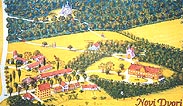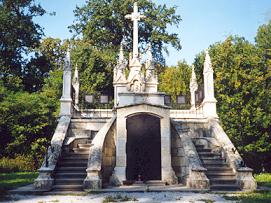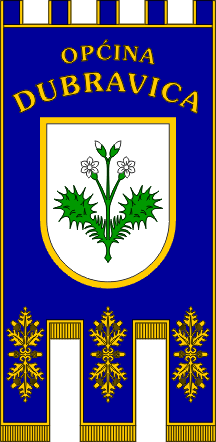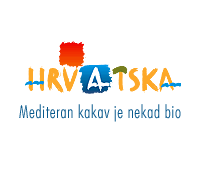|
|
|
23.
- 24.04.2005.
"A�KOV KUP" ZAGREB - CROATIA WORLD RANKING EVENT (WRE) |
|
CROATIAN CUP |
| HOME PAGE |
| INVITATION |
| NEWS |
| FIND US - MAPS |
| KIDS RACE |
| START LIST |
| RESULTS |
| ABOUT THE REGION |
| OK "VIHOR" |
 |
|
ABOUT
VILAGE DUBRAVICA
|
|
|
Zapre�i�
The town of Zapre�i�, centre of the entire area, is located 17 km west of Zagreb, at an elevation of 130 m. It is situated on a regional road and railway, along the international railroad Zagreb - Ljubljana - Central and Western Europe. The economy of this town with a population of 20,000 is based on manufacturing of ceramics, porcelain and fireproof goods, chemical and metalworking industries and production of industrial gases.
Jela�i�'s Novi Dvori Castle
 The
town itself and its immediate vicinity feature a number of attractions
for visitors. The most beautiful and interesting are castles. One should
certainly mention the Jela�i�'s Novi Dvori Castle, a unique monument
of cultural and historical heritage, located only 1.5 km from the centre
of Zapre�i� (20-odd km from Zagreb), along the road leading to the region
of Croatian Zagorje. The castle is a unique example of preservation
of the integral landed estate. Although being an exceptionally valuable
monument, after 1945 the estate was left to deteriorate. Its partial
reconstruction started in 1991.
The
town itself and its immediate vicinity feature a number of attractions
for visitors. The most beautiful and interesting are castles. One should
certainly mention the Jela�i�'s Novi Dvori Castle, a unique monument
of cultural and historical heritage, located only 1.5 km from the centre
of Zapre�i� (20-odd km from Zagreb), along the road leading to the region
of Croatian Zagorje. The castle is a unique example of preservation
of the integral landed estate. Although being an exceptionally valuable
monument, after 1945 the estate was left to deteriorate. Its partial
reconstruction started in 1991.
 The
Novi Dvori complex, covering an area of 20.5
ha, comprises a castle, St. Joseph's chapel, the Jela�i� family vault,
a landscape garden, an orchard, residential and estate buildings, a
vegetable garden, arable land and a forest park. The Novi Dvori Castle
was mentioned under the name Curia nova as early as the end of the 16th
century, as one of the mansions of the nobility of Susedgrad and Stubica,
owned by the Zrinskis, owners of Susedgrad (Stari Dvori). However, in
a document certified by the court in 1852, the foundation year mentioned
was 1611. The Novi Dvori was at that time merely a two-storey manor,
built mostly of wood.
The
Novi Dvori complex, covering an area of 20.5
ha, comprises a castle, St. Joseph's chapel, the Jela�i� family vault,
a landscape garden, an orchard, residential and estate buildings, a
vegetable garden, arable land and a forest park. The Novi Dvori Castle
was mentioned under the name Curia nova as early as the end of the 16th
century, as one of the mansions of the nobility of Susedgrad and Stubica,
owned by the Zrinskis, owners of Susedgrad (Stari Dvori). However, in
a document certified by the court in 1852, the foundation year mentioned
was 1611. The Novi Dvori was at that time merely a two-storey manor,
built mostly of wood.
 Josip
Jela�i� (1801-1859) was appointed the Croatian
viceroy in 1848 and held that office until his death. He was remembered
in history as the viceroy who abolished serfdom in Croatia in 1848.
In the second half of the 19th century, a monument was dedicated to
him on the central square of Zagreb, made by the Viennese artist Anton
Fernkorn. After the Second World War the monument was removed and dismantled.
Fortunately, its parts were preserved so that in 1990 the monument could
be reconstructed and returned to the central square, which was again
named Jela�i�'s Square.
Josip
Jela�i� (1801-1859) was appointed the Croatian
viceroy in 1848 and held that office until his death. He was remembered
in history as the viceroy who abolished serfdom in Croatia in 1848.
In the second half of the 19th century, a monument was dedicated to
him on the central square of Zagreb, made by the Viennese artist Anton
Fernkorn. After the Second World War the monument was removed and dismantled.
Fortunately, its parts were preserved so that in 1990 the monument could
be reconstructed and returned to the central square, which was again
named Jela�i�'s Square.
Its owners were the Zrinskis, the �ikulins, the Sermages, the Festeti�s and the Erd�dy Counts. The Croatian viceroy Josip Jela�i� bought it from the Erd�dys in 1851. The Jela�i� family possessed the Novi Dvori until 1934, when �uro Jela�i�'s daughters, Vera and Anka, bestowed it under their will upon the Croatian people.
Viceroy Josip Jela�i� had commissioned the reconstruction of the castle and of the entire estate. In the eastern part the castle was extended for 18 metres, the upper storey was also extended and reconstructed, the roof was covered with roof tiles, the front and a large cellar were redecorated. The landscape garden around the castle was also made. In 1855, on a lawn near the castle, Jela�i� had a neo-Gothic chapel of St. Joseph built. When, in September 1855, his nine-month-old daughter Anna suddenly died in Bohemia, a tomb was made in the chapel. Viceroy Josip Jela�i� was also buried in the same tomb, on 26 May 1859, and his brother Antun, in 1875. After 1945 the chapel was plundered and the tomb desecrated. In February 1991, before the reconstruction of the chapel, the remains were temporarily placed at Mirogoj Cemetery and in October 1992 again buried into the reconstructed family vault. The neo-Gothic family vault, made of white stone (brought from the Cathedral after it had been severely damaged by an earthquake) according to designs by H. Boll�, was made by the sculptor I. Franz in 1884. Count �uro Jela�i� had it built under his brother Josip's will.
The preserved and partly reconstructed estate buildings are also very valuable. The round thresher is the oldest installation of the kind in Croatia, dating back to the 17th century. In 1987, the former three-storey granary was turned into the "Matija Skurjeni" Gallery. It houses a permanent display of paintings by the famous naive art painter Skurjeni, as well as an exhibition of historical photographs "Novi Dvori Jela�i�evi".
From One Castle to Another
 The
Lu�nica Castle is a two-storey Baroque structure. It was built
at the beginning of the 18th century. This first-category monument is
located 1 km from Zapre�i� and was once owned by the Rauch family. It
has three wings and a U-shaped ground plan. The central wing is distinguished
by a projection, with cylindrical towers on the corners. Above the main
entrance, opposite the park, there is a large balcony. The fronts above
the windows are ornamented with a variety of fine relief busts. The
castle chapel features a rococo-style altar.
The
Lu�nica Castle is a two-storey Baroque structure. It was built
at the beginning of the 18th century. This first-category monument is
located 1 km from Zapre�i� and was once owned by the Rauch family. It
has three wings and a U-shaped ground plan. The central wing is distinguished
by a projection, with cylindrical towers on the corners. Above the main
entrance, opposite the park, there is a large balcony. The fronts above
the windows are ornamented with a variety of fine relief busts. The
castle chapel features a rococo-style altar.
 The
Janu�evec Castle, 6 km west of Zapre�i�, is
the most beautiful classicist-style castle in Croatia. It was commissioned,
most probably around 1830, by General Vrkljan, the minister of Marie-Louise,
the Grand Duchess of Parma, Napoleon's second wife. Plans were probably
made by B. Felbinger. Later, in 1845, the castle was sold to E. Corberon;
afterwards it frequently changed its owners. In May 1945 it was heavily
damaged by explosions. The building reconstruction has been performed.
The castle has a rectangular ground plan; the major north-south axis
is emphasized by colonnaded porticoes and on the western side there
is a loggia. The central round hall has an 11-m high dome. Some of the
rooms in Janu�evec used to be adorned with mural paintings displaying
panoramic views of various towns. There is a park around the castle.
Janu�evec is a monument of the highest category.
The
Janu�evec Castle, 6 km west of Zapre�i�, is
the most beautiful classicist-style castle in Croatia. It was commissioned,
most probably around 1830, by General Vrkljan, the minister of Marie-Louise,
the Grand Duchess of Parma, Napoleon's second wife. Plans were probably
made by B. Felbinger. Later, in 1845, the castle was sold to E. Corberon;
afterwards it frequently changed its owners. In May 1945 it was heavily
damaged by explosions. The building reconstruction has been performed.
The castle has a rectangular ground plan; the major north-south axis
is emphasized by colonnaded porticoes and on the western side there
is a loggia. The central round hall has an 11-m high dome. Some of the
rooms in Janu�evec used to be adorned with mural paintings displaying
panoramic views of various towns. There is a park around the castle.
Janu�evec is a monument of the highest category.
 The
Ladu� Castle is situated 7 km from Zapre�i�. It was commissioned
by the owner of the Ladu� estate, Baron Vladimir Vranyczany, and built
by the architect K. Waidman in 1882. It is a two-storey castle with
a projection on the front. The monumental two-winged stairway with stone
balustrades leads to the rooms in the first floor with their ceilings
adorned with fine decorations by Ivan Klausen. In front of the castle
there is a French-style garden.
The
Ladu� Castle is situated 7 km from Zapre�i�. It was commissioned
by the owner of the Ladu� estate, Baron Vladimir Vranyczany, and built
by the architect K. Waidman in 1882. It is a two-storey castle with
a projection on the front. The monumental two-winged stairway with stone
balustrades leads to the rooms in the first floor with their ceilings
adorned with fine decorations by Ivan Klausen. In front of the castle
there is a French-style garden.
The Baroque castle of the Or�i� family in Gornja Bistra was erected in the second half of the 18th century. It is a two-storey structure of congruous proportions and a U-shaped ground plan, with a representative portal and a court chapel at its side. The central oval hall features illusionist-style paintings of mythological content from 1778. A large park with an alley surrounds the castle. Gornja Bistra is a monument of the highest category.
 The
Jakovlje castle features a park with sculptures.
The
Jakovlje castle features a park with sculptures.
Churches of the Zapre�i� region
 Castles
are not the only attraction of the Zapre�i� region. One should see other
historical and cultural monuments. In the very town of Zapre�i� there
is a monument memorializing the fallen in the Homeland War, made by
the sculptor Drago Grgas-Beli. There is also a monument to the novelist
Ante Kova�i�, made by Jure �aja. Park sculptures by Lopati�, Von�ina
and Grgas are also worth seeing. In Brdovec, 3 km northwest of Zapre�i�,
whose first mention dates back to 1334, there is the Baroque parish
church of St. Vitus and a belfry with loopholes. The Native Museum featuring
historical and ethnographical collections was opened in Brdovec in 1973.
Within the Museum there is also the Art Salon. The Baroque-style parish
church of St. George in Donja Pu��a, 7 km north of Zapre�i�, features
three classicist altars, the pulpit and the pew, as well as two chalices
from the 18th century. In the chapel of Our Lady "�islavska"
there is a Baroque main altar from 1722, two rococo-style altars, the
pulpit with the Evangelists painted on it and a series of painting depicting
Stations of the Cross. Near the main road there is a Baroque stone statue
of St. Florian from 1778.
Castles
are not the only attraction of the Zapre�i� region. One should see other
historical and cultural monuments. In the very town of Zapre�i� there
is a monument memorializing the fallen in the Homeland War, made by
the sculptor Drago Grgas-Beli. There is also a monument to the novelist
Ante Kova�i�, made by Jure �aja. Park sculptures by Lopati�, Von�ina
and Grgas are also worth seeing. In Brdovec, 3 km northwest of Zapre�i�,
whose first mention dates back to 1334, there is the Baroque parish
church of St. Vitus and a belfry with loopholes. The Native Museum featuring
historical and ethnographical collections was opened in Brdovec in 1973.
Within the Museum there is also the Art Salon. The Baroque-style parish
church of St. George in Donja Pu��a, 7 km north of Zapre�i�, features
three classicist altars, the pulpit and the pew, as well as two chalices
from the 18th century. In the chapel of Our Lady "�islavska"
there is a Baroque main altar from 1722, two rococo-style altars, the
pulpit with the Evangelists painted on it and a series of painting depicting
Stations of the Cross. Near the main road there is a Baroque stone statue
of St. Florian from 1778.
In Marija Gorica, 9 km from Zapre�i�, there is the parish (once Franciscan) church of Our Lady of the Visitation from the mid-18th century. The Baroque church has a quadrangular sanctuary, with the sacristy next to it, and a belfry next to the main front. It features a wooden Gothic statue of the Virgin Mary from the first half of the 15th century, a tombstone with the relief portrait of the Ogulin captain M. Mogori� from 1679, the Baroque-style main altar made of stone, wooden side altars, confessionals, the pulpit (1762) and the organ (1759). Not far from the church there is a parish mansion and the monument to the novelist A. Kova�i�, made by the famous sculptor V. Radau�.
St. Nicholas' church in Poljanica was erected in 1631 and restored in 1925. There is a monument to the famous writer August �enoa in Jablanovec. The famous stone remnants known as "Kameni svatovi" (a stone wedding procession) are also worth seeing.
The historical and cultural monuments of the Dubravica municipality include the parsonage in Rozga, the monument of the highest category, St. Anna's church in Rozga (1842) and a chapel on the local cemetery in Rozga (part of it dating back to 1609). Dubravica is the birthplace of Pavao �toos, whose house has a memorial plate. Natural attractions of Dubravica include an eco-site - the natural habitat of insectivorous plants, and the Cret forest in Lugarski Brijeg.
 The
municipality of Luka is full of typical Zagorje hills, streams, marshes
and groves. The area provides good opportunities for excursions, recreational
walking and angling. In Luka there is also the famous excursion resort
"Dva potoka", Ulica B. Masnjaka 122, phone: +385 1 793-484,
with accommodation possibilities in rustic style.
The
municipality of Luka is full of typical Zagorje hills, streams, marshes
and groves. The area provides good opportunities for excursions, recreational
walking and angling. In Luka there is also the famous excursion resort
"Dva potoka", Ulica B. Masnjaka 122, phone: +385 1 793-484,
with accommodation possibilities in rustic style.
Cherishing the Tradition
Old folk customs are cherished and the ethnological treasure carefully
preserved in Zapre�i� and its surroundings. There are two groups that
greatly contribute to preservation of the tradition - the Zapre�i� majorettes
"Jela�i�ke" and the group called "Plemi�ka mlade� Zapre�i�a"
(The Noble Youth of Zapre�i�), that revives the days of Jela�i� with
their luxurious ball toilets, officer uniforms and dances.
In the Brdovec area there are two cultural societies, "Janu�evec" and "Mihovil Kru�lin". Famous is also the Parish Choir "St. Vitus". In the municipality of Luka there is also a majorette group called "Lu�anke" and a brass band.
Zapre�i� and its surroundings host a number of traditional and occasional cultural and sports events. In May and October, on the occasion of Jela�i�'s anniversaries, the "Jela�i�'s Days" take place, a series of events dedicated to the Viceroy. The carnival "Fa�ni�ki �pancir" takes place in February. In July, apart from the International Folklore Festival in Zagreb, there is also the "Harvest Festival". Among sports events one should mention the Croatian motocross championship on Pepa�ev Breg in Savski Marof, traditionally held on Easter Monday, the motor-gliding championship in May, the riding events organized by "Trajbar Team" in May and October, the table tennis event "Jo�e Vogrinec Memorial" in June and the cycling event "V. Horvati� Memorial" in September.
The municipality of Luka is known for the traditional folk feast and patron saint's day - St. Roch. Merry carnival processions are also organized.
Ornithological Reserve
 Nature
lovers and recreation enthusiasts are offered a number of opportunities
in the Zapre�i� region. South of the Zapre�i� centre, towards the Sava,
there is the Zajarki Lake, a large gravel pit. It is a popular bathing
place, visited by inhabitants of Zapre�i� but also Zagreb. Farther towards
the Sava there is the ornithological reserve Zapre�i�-Sava, covered
with groves and dense low vegetation, and intersected with marshy meadows.
It provides nesting and migrating place for many birds. The nearby rivers,
the Krapina and the Sava with its tributaries, as well as the Zajarki
Lake (with a fish hatchery) provide excellent opportunities for anglers.
Zapre�i� has two hunting societies, LD "Zapre�i�" and LD "Kuna"
Jablanovec.
Nature
lovers and recreation enthusiasts are offered a number of opportunities
in the Zapre�i� region. South of the Zapre�i� centre, towards the Sava,
there is the Zajarki Lake, a large gravel pit. It is a popular bathing
place, visited by inhabitants of Zapre�i� but also Zagreb. Farther towards
the Sava there is the ornithological reserve Zapre�i�-Sava, covered
with groves and dense low vegetation, and intersected with marshy meadows.
It provides nesting and migrating place for many birds. The nearby rivers,
the Krapina and the Sava with its tributaries, as well as the Zajarki
Lake (with a fish hatchery) provide excellent opportunities for anglers.
Zapre�i� has two hunting societies, LD "Zapre�i�" and LD "Kuna"
Jablanovec.
From Riding to Flying
 Zapre�i�
and its surroundings are famous for sports. Apart from a football stadium
there are football grounds, sports halls, bowling alleys, tennis courts,
orienteering maps... The "Lamaki" Tennis Club has outdoor
and indoor tennis courts. There are also opportunities to go in for
rather unusual sports - baseball,
Zapre�i�
and its surroundings are famous for sports. Apart from a football stadium
there are football grounds, sports halls, bowling alleys, tennis courts,
orienteering maps... The "Lamaki" Tennis Club has outdoor
and indoor tennis courts. There are also opportunities to go in for
rather unusual sports - baseball,  paragliding and motor-gliding. In the Riding club "Trajbar Team"
one can have a recreational ride, attend a "normal" riding
school or - which is rather rare in Europe - a sports riding school
under the guidance of a licensed coach. The club has also an indoor
riding hall, a caf� and a restaurant. The motocross course on the hill
Pepa�ev Breg in Prigorje Brdove�ko is very attractive for spectators.
In its immediate vicinity there are sports grounds of TC "Mont
Antonio".
paragliding and motor-gliding. In the Riding club "Trajbar Team"
one can have a recreational ride, attend a "normal" riding
school or - which is rather rare in Europe - a sports riding school
under the guidance of a licensed coach. The club has also an indoor
riding hall, a caf� and a restaurant. The motocross course on the hill
Pepa�ev Breg in Prigorje Brdove�ko is very attractive for spectators.
In its immediate vicinity there are sports grounds of TC "Mont
Antonio".
Informations from: Zagreb county tourist board
 Dubravica
is a community in north-western corner of the Zagreb County some
20 km NW of Zagreb. Population about 5,500, the main vilage of
the same name having no more then about 500. In 1992 when the
administrative reform in Croatia was made the region was prescribed
to be part of the community of Hru�evec Kupljenski, however this
was against the wish of the local population and such community
was never constituted. Rather the community of Dubravica was estabished
already in 1995.
Dubravica
is a community in north-western corner of the Zagreb County some
20 km NW of Zagreb. Population about 5,500, the main vilage of
the same name having no more then about 500. In 1992 when the
administrative reform in Croatia was made the region was prescribed
to be part of the community of Hru�evec Kupljenski, however this
was against the wish of the local population and such community
was never constituted. Rather the community of Dubravica was estabished
already in 1995. The
plant seems to be a Drosera. The genus Drosera is the type of
the family Droseraceae. Droseras are small plants which trap insects
on their leaves, covered with sticky glandulous hairs, and slowly
"digest" them by releasing proteolytic enzymes. The
droseras lives in marshes and peat bogs, where their dense colonies
can form kinds of floating mats. The most common drosera is Drosera
rotundifolia. All droseras are endangered and protected, although
it is difficult to avoid trampling them in places where they are
very common, as for instance the Lofoten island in northern Norway.
The
plant seems to be a Drosera. The genus Drosera is the type of
the family Droseraceae. Droseras are small plants which trap insects
on their leaves, covered with sticky glandulous hairs, and slowly
"digest" them by releasing proteolytic enzymes. The
droseras lives in marshes and peat bogs, where their dense colonies
can form kinds of floating mats. The most common drosera is Drosera
rotundifolia. All droseras are endangered and protected, although
it is difficult to avoid trampling them in places where they are
very common, as for instance the Lofoten island in northern Norway.

